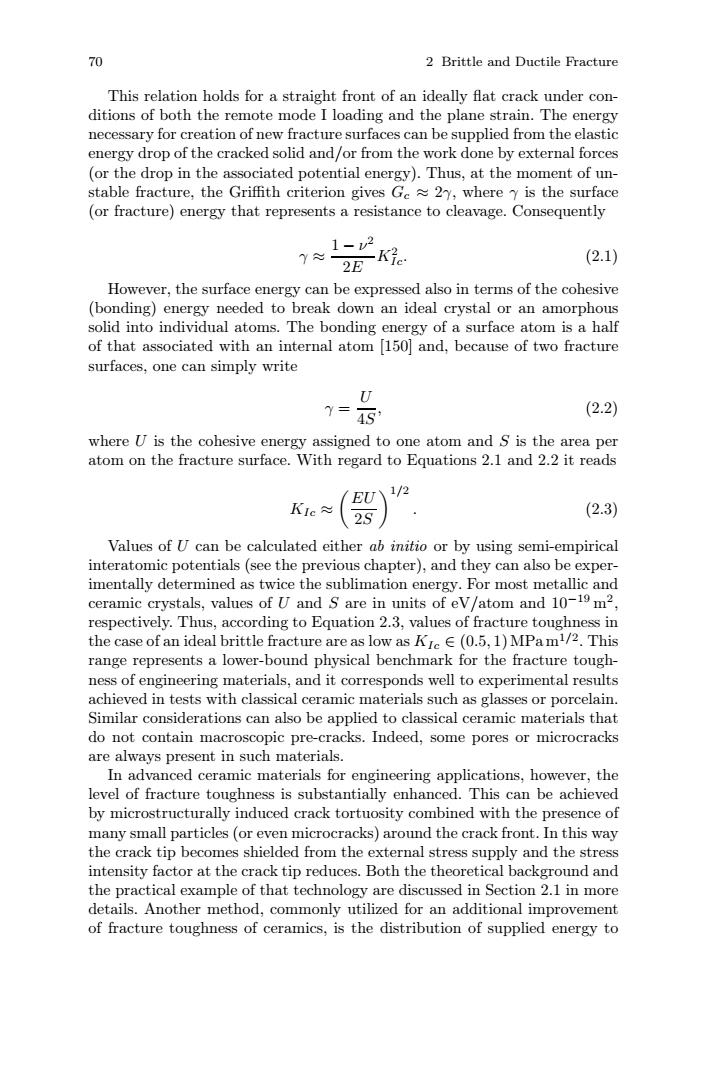正在加载图片...

70 2 Brittle and Ductile Fracture This relation holds for a straight front of an ideally flat crack under con- ditions of both the remote mode I loading and the plane strain.The energy necessary for creation of new fracture surfaces can be supplied from the elastic energy drop of the cracked solid and/or from the work done by external forces (or the drop in the associated potential energy).Thus,at the moment of un- stable fracture,the Griffith criterion gives Ge2y,where y is the surface (or fracture)energy that represents a resistance to cleavage.Consequently 71~2 2E Kie (2.1) However,the surface energy can be expressed also in terms of the cohesive (bonding)energy needed to break down an ideal crystal or an amorphous solid into individual atoms.The bonding energy of a surface atom is a half of that associated with an internal atom 150 and,because of two fracture surfaces,one can simply write U Y=4S' (2.2) where U is the cohesive energy assigned to one atom and S is the area per atom on the fracture surface.With regard to Equations 2.1 and 2.2 it reads EU 1/2 KIc≈ 2S (2.3) Values of U can be calculated either ab initio or by using semi-empirical interatomic potentials(see the previous chapter),and they can also be exper- imentally determined as twice the sublimation energy.For most metallic and ceramic crystals,values of U and S are in units of ev/atom and 10-19 m2. respectively.Thus,according to Equation 2.3,values of fracture toughness in the case of an ideal brittle fracture are as low as KIeE(0.5,1)MPam1/2.This range represents a lower-bound physical benchmark for the fracture tough- ness of engineering materials,and it corresponds well to experimental results achieved in tests with classical ceramic materials such as glasses or porcelain. Similar considerations can also be applied to classical ceramic materials that do not contain macroscopic pre-cracks.Indeed,some pores or microcracks are always present in such materials. In advanced ceramic materials for engineering applications,however,the level of fracture toughness is substantially enhanced.This can be achieved by microstructurally induced crack tortuosity combined with the presence of many small particles (or even microcracks)around the crack front.In this way the crack tip becomes shielded from the external stress supply and the stress intensity factor at the crack tip reduces.Both the theoretical background and the practical example of that technology are discussed in Section 2.1 in more details.Another method,commonly utilized for an additional improvement of fracture toughness of ceramics,is the distribution of supplied energy to70 2 Brittle and Ductile Fracture This relation holds for a straight front of an ideally flat crack under conditions of both the remote mode I loading and the plane strain. The energy necessary for creation of new fracture surfaces can be supplied from the elastic energy drop of the cracked solid and/or from the work done by external forces (or the drop in the associated potential energy). Thus, at the moment of unstable fracture, the Griffith criterion gives Gc ≈ 2γ, where γ is the surface (or fracture) energy that represents a resistance to cleavage. Consequently γ ≈ 1 − ν2 2E K2 Ic. (2.1) However, the surface energy can be expressed also in terms of the cohesive (bonding) energy needed to break down an ideal crystal or an amorphous solid into individual atoms. The bonding energy of a surface atom is a half of that associated with an internal atom [150] and, because of two fracture surfaces, one can simply write γ = U 4S , (2.2) where U is the cohesive energy assigned to one atom and S is the area per atom on the fracture surface. With regard to Equations 2.1 and 2.2 it reads KIc ≈ EU 2S 1/2 . (2.3) Values of U can be calculated either ab initio or by using semi-empirical interatomic potentials (see the previous chapter), and they can also be experimentally determined as twice the sublimation energy. For most metallic and ceramic crystals, values of U and S are in units of eV/atom and 10−19 m2, respectively. Thus, according to Equation 2.3, values of fracture toughness in the case of an ideal brittle fracture are as low as KIc ∈ (0.5, 1) MPa m1/2. This range represents a lower-bound physical benchmark for the fracture toughness of engineering materials, and it corresponds well to experimental results achieved in tests with classical ceramic materials such as glasses or porcelain. Similar considerations can also be applied to classical ceramic materials that do not contain macroscopic pre-cracks. Indeed, some pores or microcracks are always present in such materials. In advanced ceramic materials for engineering applications, however, the level of fracture toughness is substantially enhanced. This can be achieved by microstructurally induced crack tortuosity combined with the presence of many small particles (or even microcracks) around the crack front. In this way the crack tip becomes shielded from the external stress supply and the stress intensity factor at the crack tip reduces. Both the theoretical background and the practical example of that technology are discussed in Section 2.1 in more details. Another method, commonly utilized for an additional improvement of fracture toughness of ceramics, is the distribution of supplied energy to